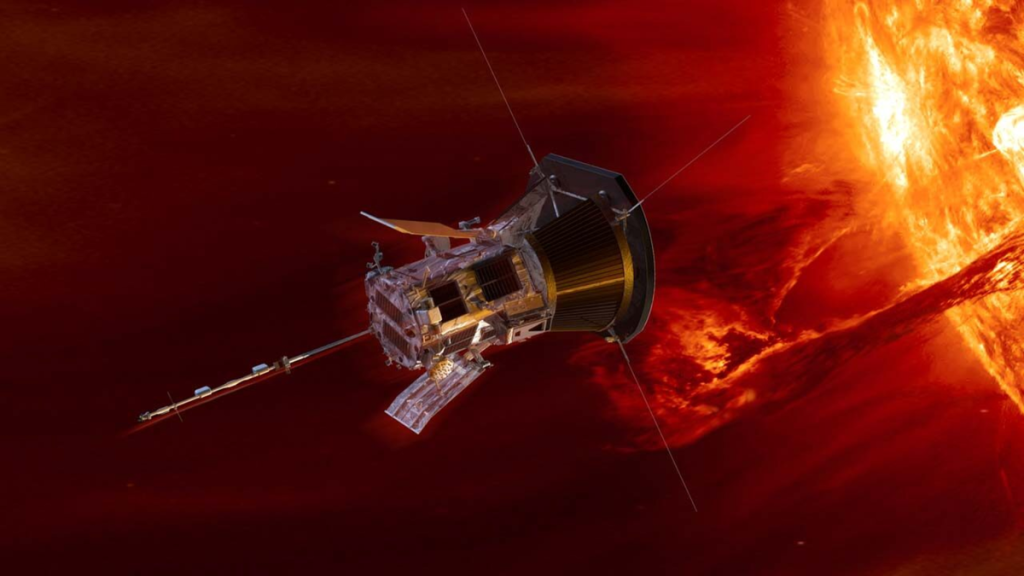On Nov. 6, NASA’s Parker Solar Probe passed within 234 miles (376 kilometers) of Venus’ surface. The purpose of this close flyby was to accomplish a gravity-assist maneuver, in which the probe would steal some of Venus‘ momentum to change the spacecraft’s orbit and bring itself even closer to the sun.
The Parker Solar Probe had already made several close passes of the sun, but the recent flyby was its closest, coming within about 3.8 million miles (6 million km) of the solar surface. That’s less than nine times the radius of the sun.
At the moment of closest approach, Parker was traveling at nearly 435,000 mph (700,000 km/h), making it the fastest object ever designed by humans. To give you a sense of just how fast that is, Parker gives us the rare opportunity to switch units: We can reasonably express its speed as 0.06% the speed of light.
The goal of the Parker Solar Probe mission is to investigate the mysteries of the sun’s corona, its outer atmosphere. Specifically, for decades, we’ve known that the visible surface of the sun, the photosphere, has a temperature of around a few thousand kelvins, but the corona itself is in the millions of kelvins.
Related: Parker Solar Probe and Solar Orbiter team up to tackle 65-year-old sun mystery
The goal of the Parker Solar Probe mission is to investigate the mysteries of the sun’s corona, its outer atmosphere. Specifically, for decades, we’ve known that the visible surface of the sun, the photosphere, has a temperature of around a few thousand kelvins, but the corona itself is in the millions of kelvins.
It’s like switching on a light bulb, and the bulb is warm to the touch but the air around it is a thousand times hotter. What gives?
We know that the corona can’t be heated through normal heat-transfer processes, because that would violate the second law of thermodynamics — the cooler surface can’t deliver heat to the warmer corona. So it has to be some other process, and it has to involve magnetic fields, which play a large and dynamic role in the physics of the corona.
Ironically, it doesn’t take that much energy to heat up the corona, and that’s because of the role helium plays in the calculation.
Helium makes up about 25% of the sun’s mass. The temperatures at the photosphere are cool enough that helium, which normally carries two electrons, loses one of them. We call this a partially ionized state. This allows helium to easily pump out a lot of radiation, which contributes to the general glowing of the sun. But it also keeps the temperature in check, because there’s an easy “escape hatch” for the sun’s heat.
Once things heat up a bit, however, the helium loses its other electron, and it becomes fully ionized. This makes it much, much harder to release radiation, which means it’s much better at trapping heat. Solar physicists call this transition “evaporation” through an analogy with boiling water to make steam.
The upshot is that you don’t need that much energy — something like 1 kilowatt for every square meter — to heat the corona to ridiculously high temperatures. That’s like covering the surface of the sun in dishwashers, which amounts to less than 0.0025% of the total energy emitted by the sun.
This means that whatever we use to heat up the corona, we can be really, really inefficient with it and it will still likely do the trick.
And this is where the Parker Solar Probe comes in. To study this region of the sun, the probe comes with four suites of instruments, named FIELDS, WISPR, IS-O-IS and SWEAP. These instruments work together to study the corona itself, the solar wind (the stream of charged particles emanating from the corona) and the photosphere to compile a complete picture.
And this is how Parker discovered how strange waves of magnetic-field energy called switchbacks play a critical role in heating the corona.
A switchback starts in the turbulent photosphere, where plumes of plasma constantly well up to the surface and slink back down. Sometimes, regions of intense magnetic energy can form, where many field lines tangle up on each other. Some of these fields are straight, pointing away from the sun. Others loop back to the surface in the shape of a giant horseshoe.
When these two kinds of magnetic fields bump against each other, the lines can disconnect and reconnect, forming a giant S-shaped kink in the field lines. This kink, known as a switchback, travels away from the sun and deep into the corona.
Eventually, the switchback dissolves, delivering its energy. Astronomers think this is one of the most important — if not the most important — way the sun heats its corona.
This research is especially important because magnetic fields also control the evolution of space weather, which involves plasma storms that detach from the sun and go flying through the solar system. Space weather has a huge impact on satellites, human spaceflight and even our power grids. So the more we understand about the complex role of magnetic fields throughout all regions of the sun, the better we can predict and plan for solar storms of all kinds.

